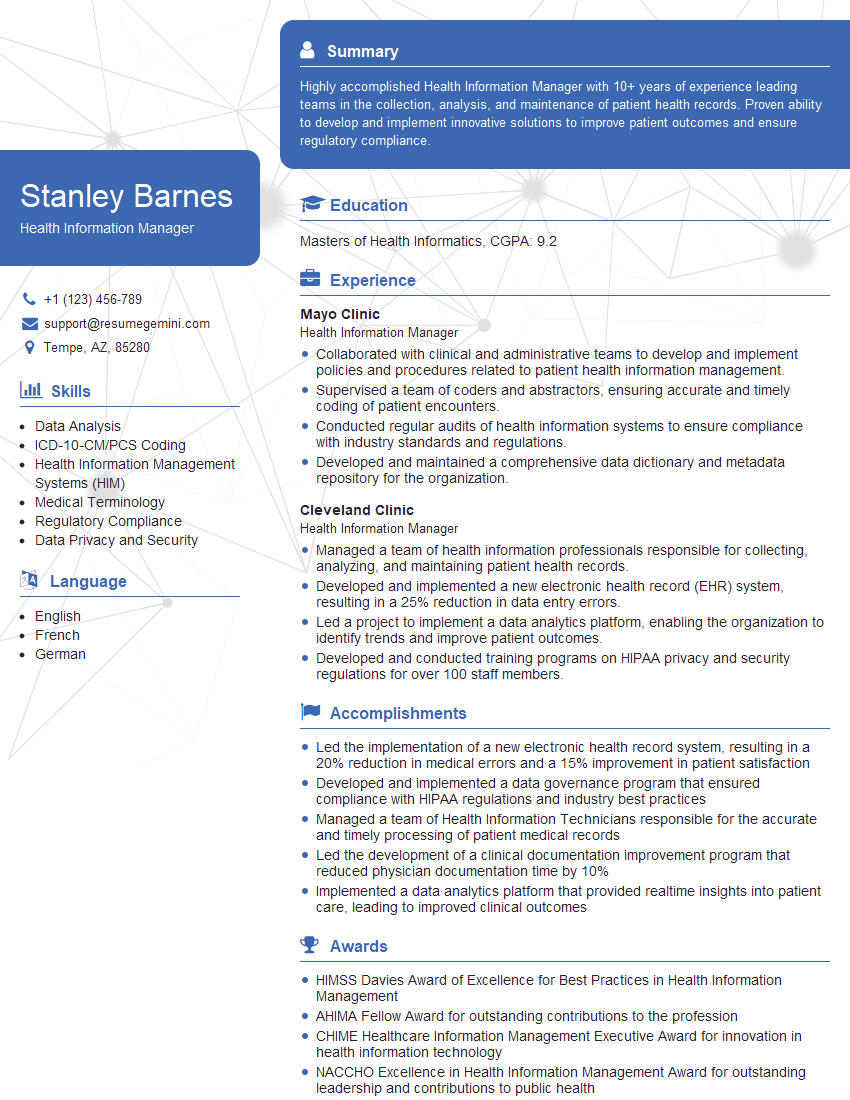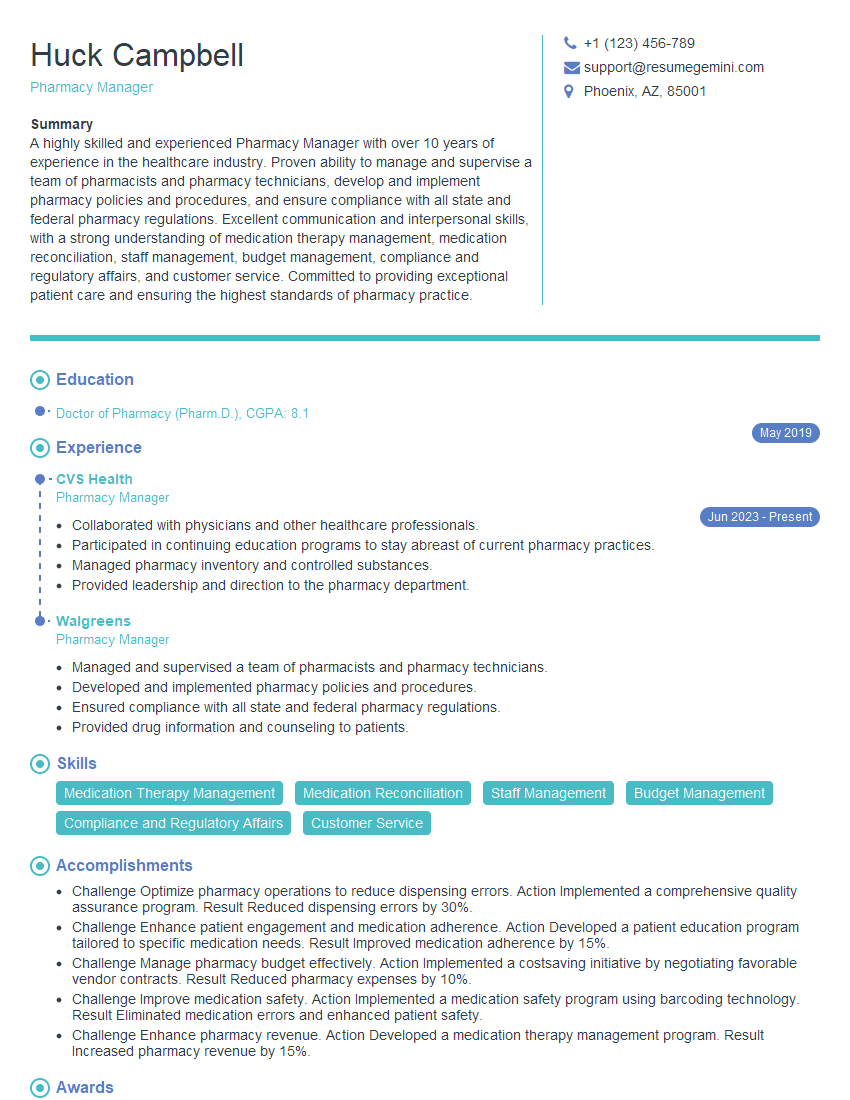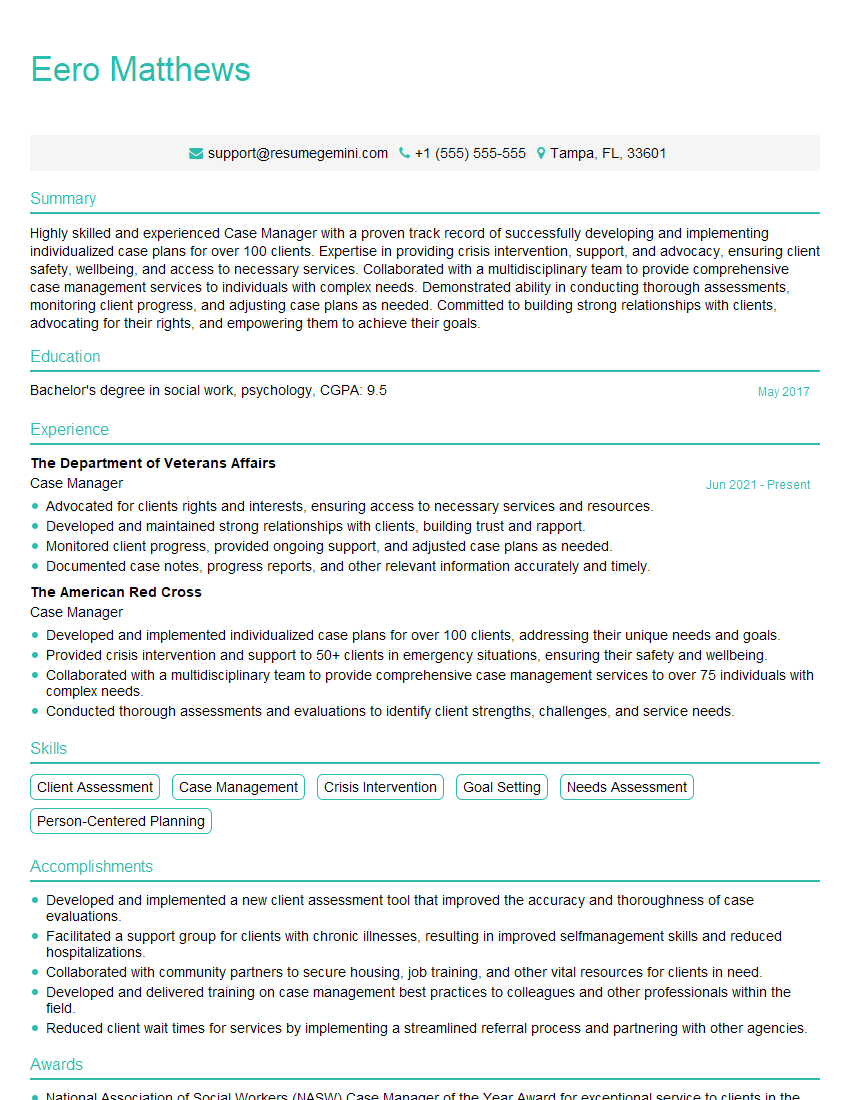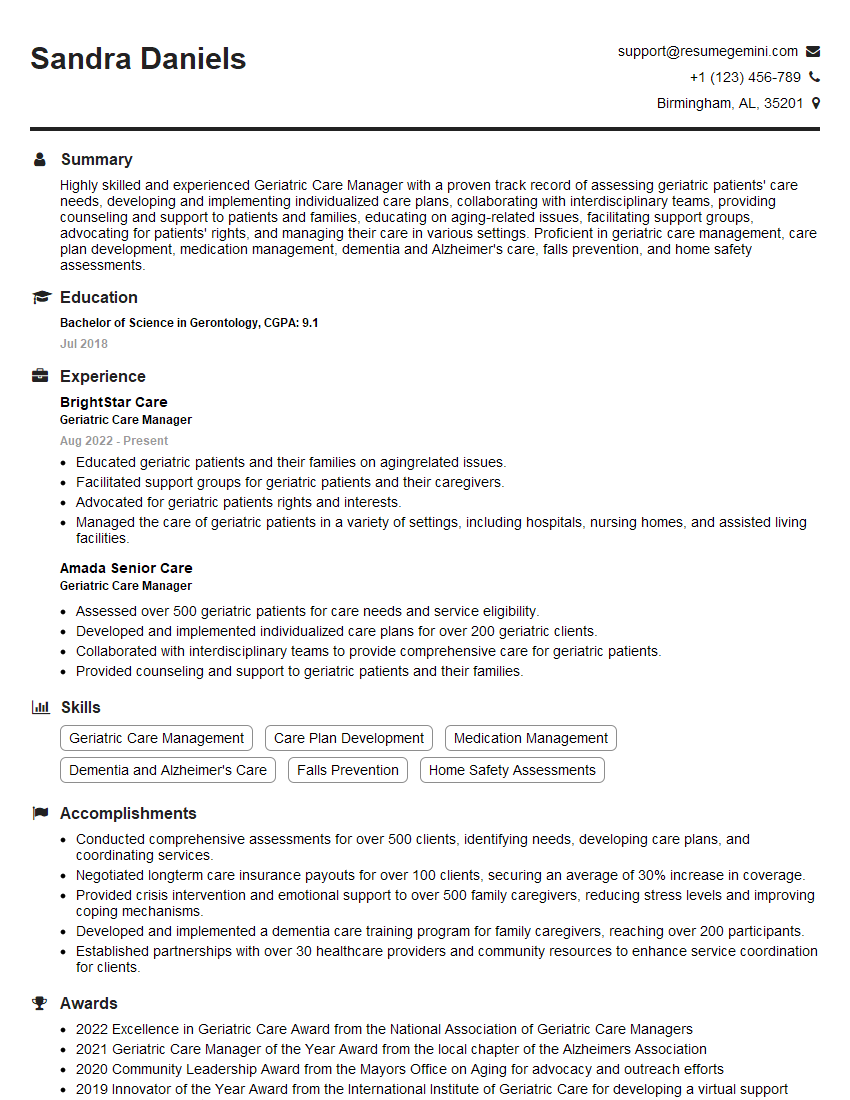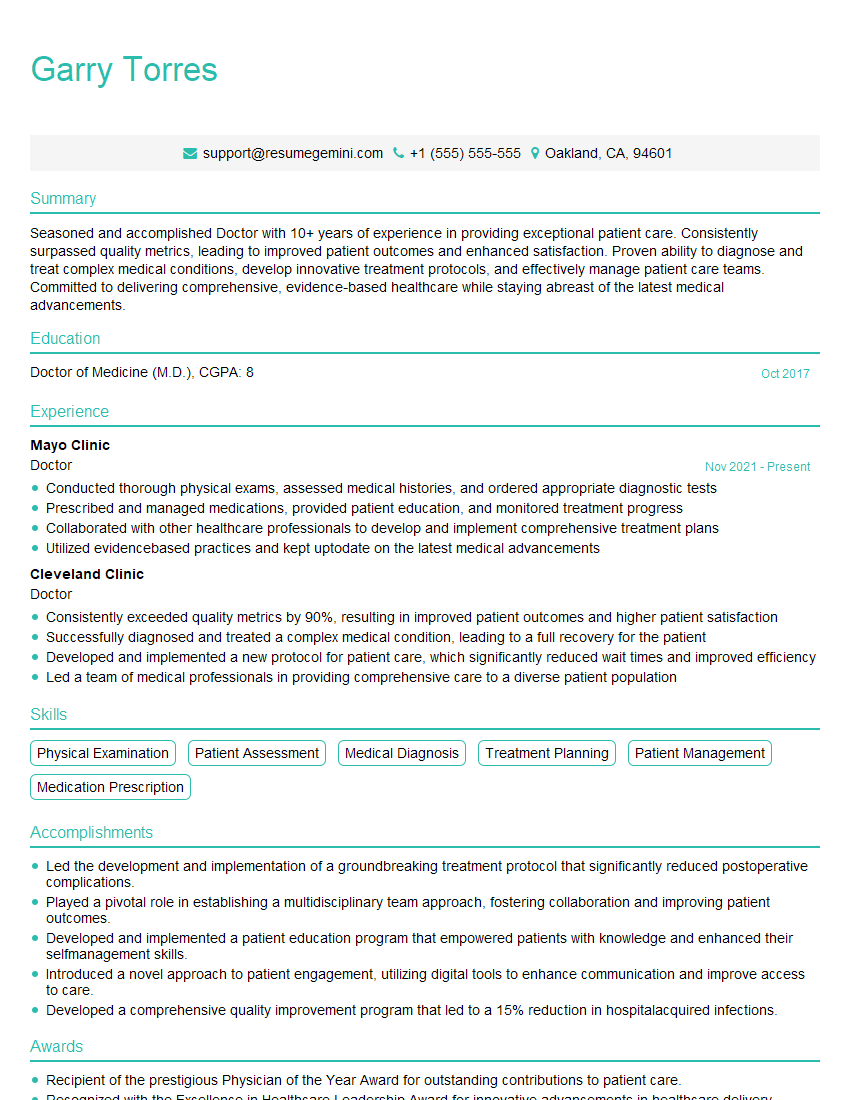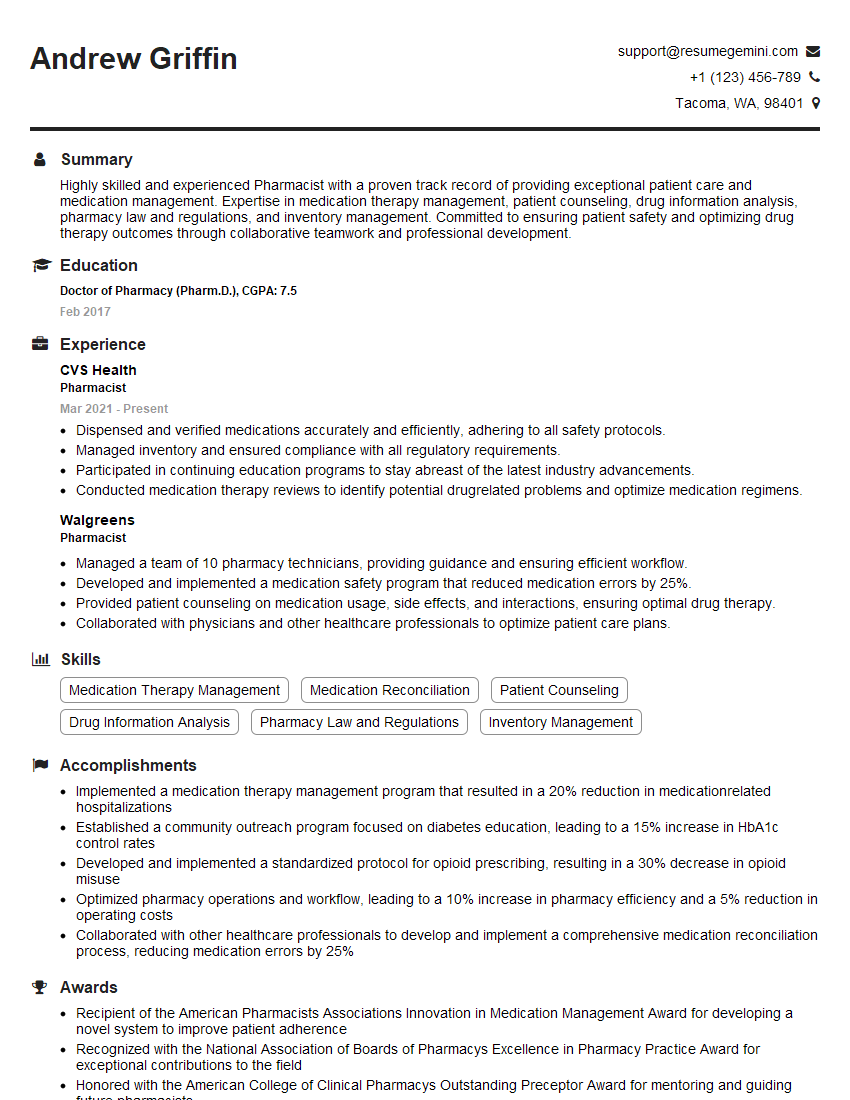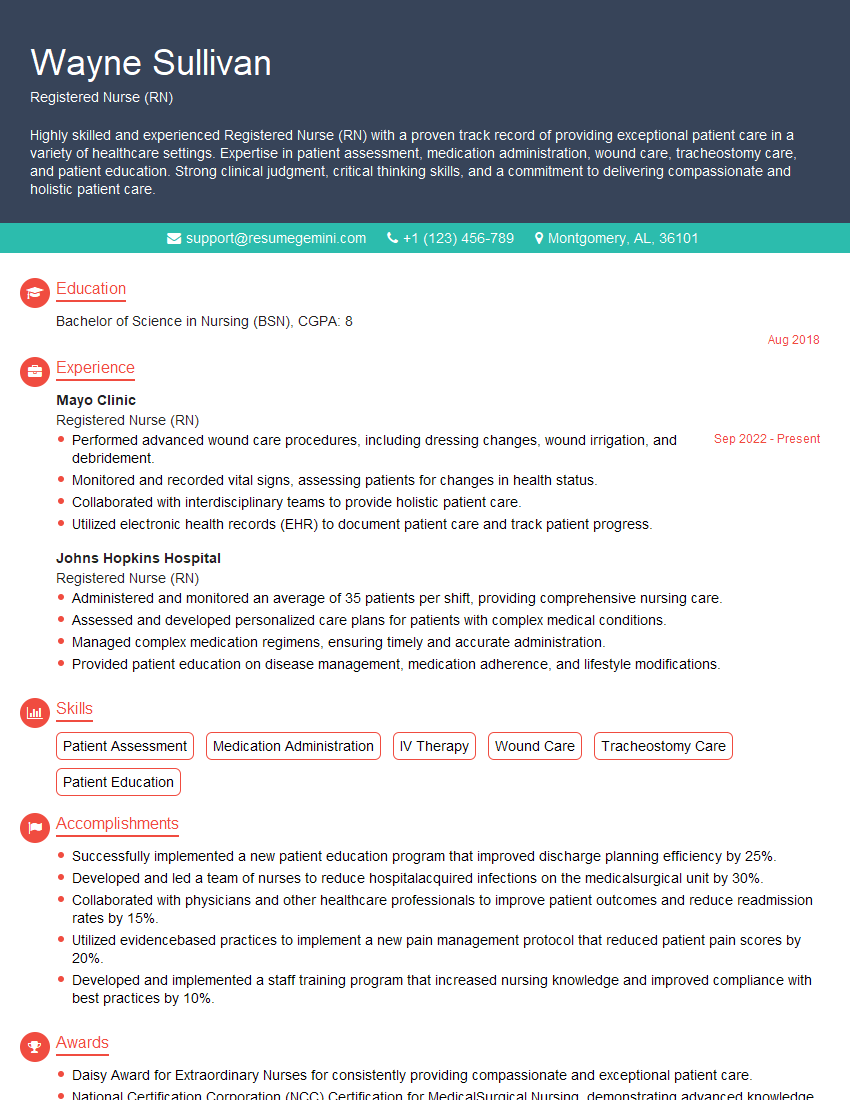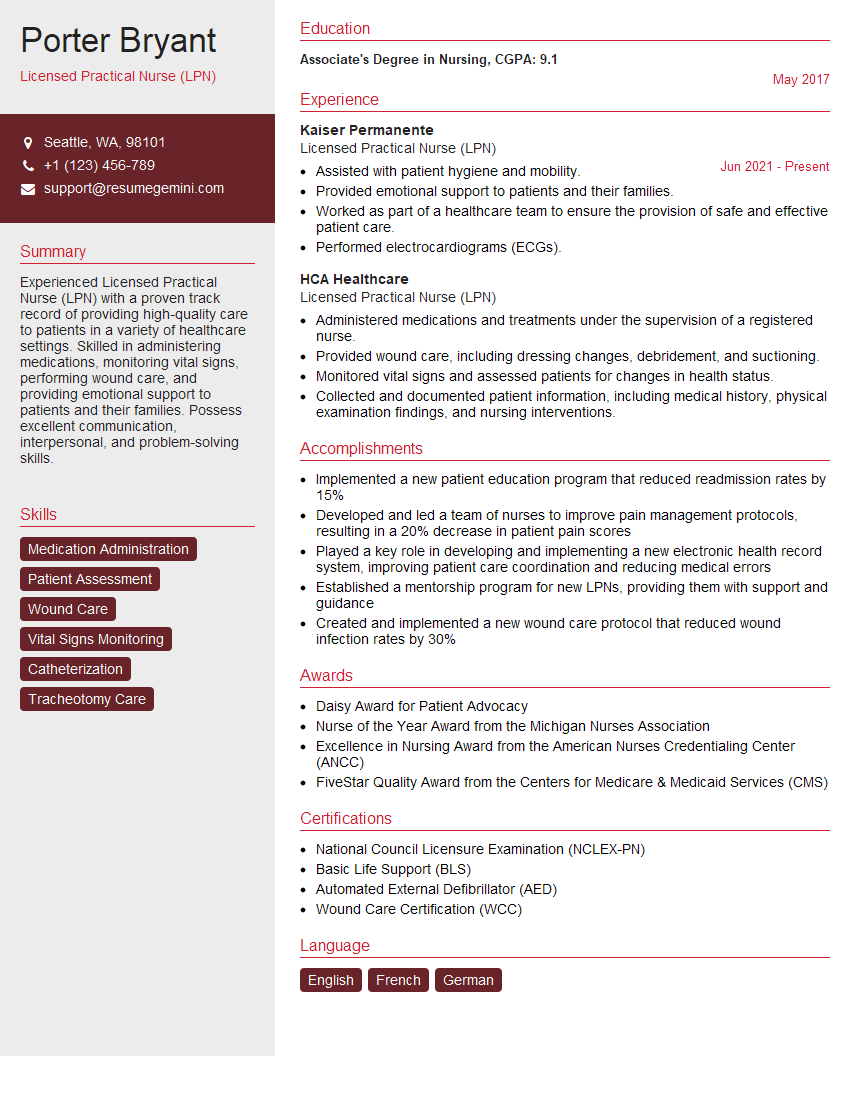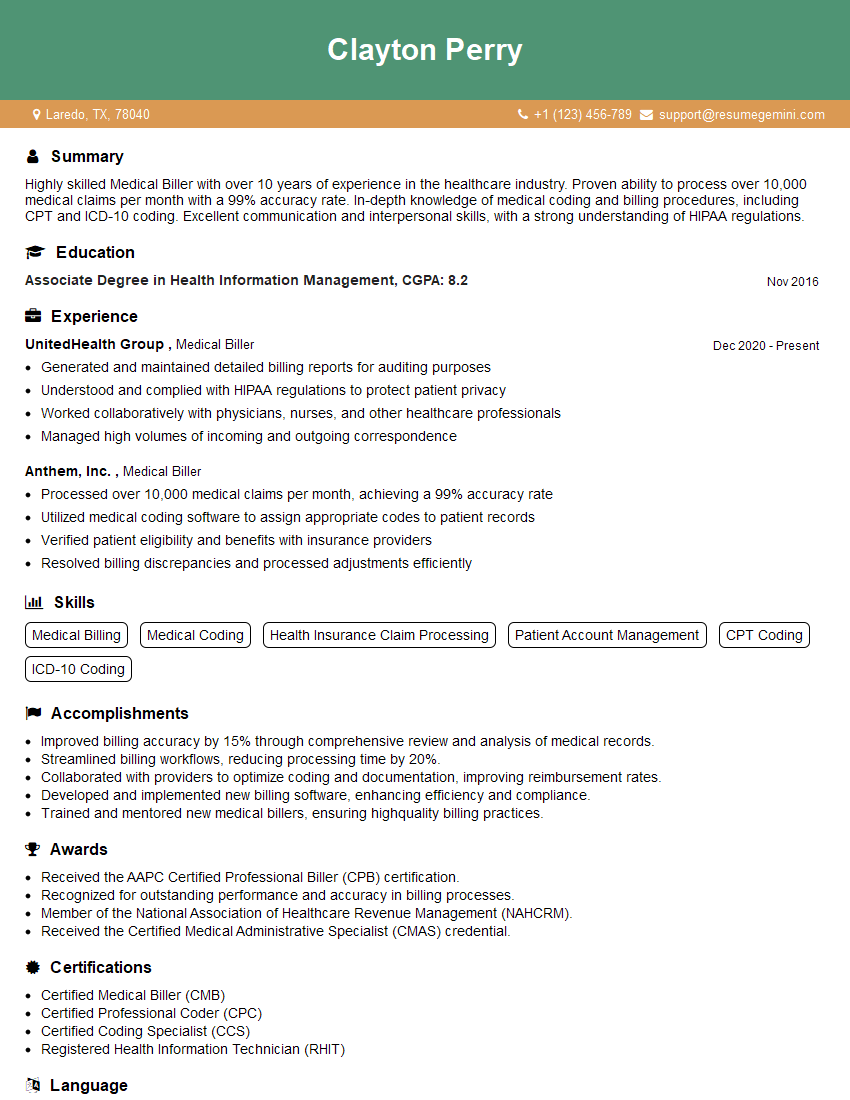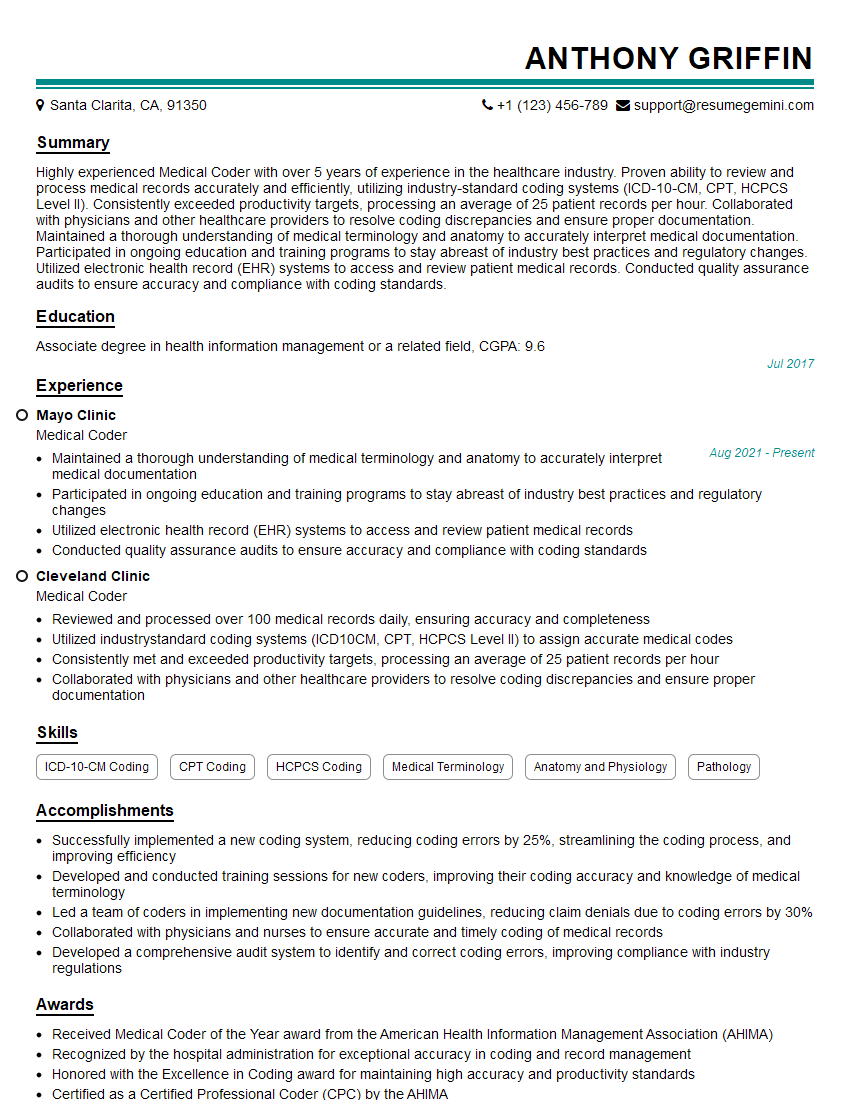The thought of an interview can be nerve-wracking, but the right preparation can make all the difference. Explore this comprehensive guide to Medication History Taking interview questions and gain the confidence you need to showcase your abilities and secure the role.
Questions Asked in Medication History Taking Interview
Q 1. Explain the importance of accurate medication history taking.
Accurate medication history taking is paramount to safe and effective patient care. It forms the foundation for appropriate diagnosis, treatment planning, and preventing adverse drug events (ADEs). Without a complete and accurate history, clinicians risk prescribing medications that interact negatively with existing drugs, causing harm or rendering treatments ineffective. For example, a patient taking a blood thinner might experience dangerous bleeding if prescribed another medication that also increases bleeding risk without the prior knowledge of the blood thinner use.
In essence, a complete medication history prevents medication errors, improves treatment outcomes, and ultimately enhances patient safety.
Q 2. Describe the process of obtaining a complete medication history from a patient.
Obtaining a complete medication history involves a systematic approach. I begin by establishing a trusting rapport with the patient. I then use a structured approach, asking about all medications: prescription drugs, over-the-counter medications, herbal remedies, vitamins, and supplements. This includes asking about the medication name, dosage, frequency, route of administration, and the reason for taking the medication.
I encourage patients to bring all their medications (in original containers) to the appointment. I visually verify the medications, clarifying any ambiguities. I also explore their past medication history, including any allergies or adverse drug reactions, documenting everything thoroughly. Finally, I utilize resources like electronic health records (EHRs) to cross-reference the patient’s report with previous medication records, ensuring consistency.
- Start with open-ended questions: “Can you tell me about the medications you are currently taking?”
- Use a standardized medication history form: This ensures consistency and completeness.
- Clarify abbreviations and dosages: Avoid assumptions; confirm the exact dosage and frequency.
- Involve family members or caregivers if necessary: This is particularly useful for patients with cognitive impairment.
Q 3. How do you handle discrepancies between patient report and medication records?
Discrepancies between patient report and medication records are common and require careful investigation. I would first politely clarify the discrepancy with the patient, asking open-ended questions to understand the possible reasons for the difference. Perhaps the patient forgot a medication, the information in the record is outdated, or there’s a misunderstanding about the medication.
I then would review the medication records thoroughly, checking for any possible clerical errors or outdated information. If the discrepancy remains unresolved after patient interview and record review, I might contact the patient’s previous healthcare providers for clarification. In situations where the patient’s report and records dramatically differ and pose safety concerns (e.g., incorrect dosage, undisclosed allergies), I would involve a senior clinician or pharmacist for guidance before proceeding with any treatment decisions. Documentation of all steps taken to resolve the discrepancy is crucial.
Q 4. What strategies do you use to ensure patient understanding and compliance?
Ensuring patient understanding and compliance is crucial. I use the teach-back method, where I explain the medication regimen clearly and then ask the patient to explain it back to me in their own words. This confirms understanding and addresses any misconceptions. I provide clear, concise, and easily understandable instructions, avoiding medical jargon.
I use visual aids like medication organizers or pill charts for complex regimens. I also involve family members or caregivers in the education process, especially for patients with cognitive impairments or those requiring support for medication management. Regular follow-up appointments and phone calls further enhance compliance and allow for addressing any concerns promptly. Tailoring the communication style to the patient’s health literacy level and learning style is also key.
Q 5. How do you manage patients with multiple medications or complex regimens?
Managing patients with multiple medications or complex regimens requires a structured and organized approach. I use tools such as medication reconciliation lists, pill organizers, and medication calendars to help patients track their medications. I prioritize a collaborative approach, involving the patient, family members (when appropriate), and pharmacists to streamline the process.
I simplify the regimen wherever possible, exploring the potential for combining medications or reducing the number of medications. I also provide clear, easy-to-understand written instructions and schedule regular follow-up appointments to assess adherence, identify potential problems, and adjust the medication regimen as needed. I always look for opportunities to use technology to assist with medication management, for example using medication apps that provide reminders and tracking capabilities.
Q 6. Explain your approach to documenting medication history.
My approach to documenting medication history is comprehensive and meticulous. I use a standardized format in the electronic health record (EHR), ensuring all information is clearly and accurately recorded. This includes the medication name (generic and brand), dosage, frequency, route of administration, start date, and reason for taking the medication.
I also document any allergies, adverse drug reactions, and significant findings from the medication reconciliation process. I use clear and concise language, avoiding abbreviations or acronyms that might be misinterpreted. All discrepancies or unresolved issues are carefully documented, along with the steps taken to address them. A complete, accurate, and readily accessible medication history is crucial for continuity of care and to prevent errors.
Q 7. How do you address potential language barriers or cognitive impairments during medication history taking?
Addressing language barriers and cognitive impairments requires sensitivity and adaptation. For language barriers, I utilize certified medical interpreters whenever possible, ensuring accurate communication. I may also use visual aids and simple language. For cognitive impairments, I involve family members or caregivers to aid in medication history taking, using simple questions and providing plenty of time for responses.
I might use visual aids or memory aids to support recall. It’s important to be patient and understanding, recognizing that the process may take longer. In cases of severe cognitive impairment, I may rely more heavily on other sources of information, such as previous medical records, but always with a careful awareness of the reliability of those records. Adaptability and flexibility are key when working with patients who have communication or cognitive challenges.
Q 8. Describe your experience with medication reconciliation.
Medication reconciliation is the process of comparing a patient’s medication list with what they are currently taking. It’s crucial for preventing medication errors and ensuring patient safety. My experience involves actively participating in this process at every patient encounter, whether it’s during admission to a hospital, transfer between care settings, or even during routine clinic visits. I meticulously review all available medication information, including prescription medications, over-the-counter drugs, herbal remedies, and supplements. This involves reviewing patient-provided lists, medication bottles, and electronic health records (EHRs). Discrepancies are carefully investigated, and any discrepancies are clarified with the patient and/or their caregivers. For example, I recently identified a discrepancy between a patient’s self-reported medication list and the list provided by their pharmacy, leading to the discovery of a missed dose of a critical medication.
I utilize a structured approach, using standardized forms and checklists to ensure a thorough and consistent process. This systematic approach minimizes the chances of missing critical information and ensures a high level of accuracy. I always document the reconciliation process meticulously in the patient’s medical record, noting any discrepancies and the actions taken to resolve them. This provides a clear audit trail and facilitates continuity of care.
Q 9. How do you verify the accuracy of medication information obtained from patients?
Verifying the accuracy of medication information requires a multi-faceted approach. I start by actively listening to the patient and encouraging them to provide as much detail as possible, including dosage, frequency, route of administration, and the reason for taking each medication. I then cross-reference this information with multiple sources. This might involve checking the patient’s medication bottles, reviewing their pharmacy records (with patient consent), and comparing the information with data from the EHR.
I use open-ended questions to encourage patients to elaborate and identify potential discrepancies. For example, instead of asking ‘Do you take aspirin?’, I might ask ‘Can you tell me about the medications you take for your heart condition?’. Furthermore, I always clarify any ambiguous information. If a patient says ‘I take a water pill,’ I need to know the exact name and dosage. I actively involve the patient and their caregivers in this verification process, fostering a collaborative approach to ensure accuracy. This includes confirming that the dosages and frequencies they describe match the information on their prescription labels. If there are conflicting reports, I explore all possibilities to arrive at the truth.
Q 10. What are some common errors in medication history taking, and how can they be avoided?
Common errors in medication history taking include omissions (forgetting to ask about OTC drugs, herbal supplements, or even vitamins), inaccuracies (incorrect dosage, frequency, or route of administration), and inconsistencies (conflicting information from different sources). These errors can have serious consequences, leading to adverse drug events and poor patient outcomes.
To avoid these errors, I use a structured approach, employing standardized checklists and forms to guide the medication history interview. I ask comprehensive questions to explore all medication use, including over-the-counter medications, herbal remedies, and supplements. I employ techniques like using visual aids (pill containers) and actively involve caregivers when necessary. I always verify the information using multiple sources, including patient reports, medication bottles, pharmacy records, and EHRs. Documenting everything meticulously is paramount. Regular training and continuing education on medication information resources and best practices are crucial for personal professional development.
- Omission Example: Forgetting to ask about herbal supplements could lead to a dangerous interaction with prescribed medication.
- Inaccuracy Example: Misunderstanding the frequency of a medication (daily vs. twice daily) can cause significant health issues.
Q 11. How do you handle patients who are reluctant to disclose their medication history?
Handling reluctant patients requires a sensitive and empathetic approach. I begin by building rapport and trust through active listening and demonstrating genuine concern for their well-being. I explain the importance of accurate medication information in providing safe and effective care. I emphasize confidentiality and reassure them that the information will be used solely for their benefit. I avoid judgmental language and focus on understanding their reasons for reluctance. Sometimes, patients may be embarrassed, worried about judgment, or simply overwhelmed. I offer flexible approaches, allowing patients to provide information at their own pace and in a comfortable setting.
If reluctance persists, I might involve a trusted family member or caregiver with their permission. Sometimes, starting with a less direct approach can be more effective. Instead of directly asking about their medications, I might start by asking about their overall health status and then gently guide the conversation towards their medication use. It’s crucial to be patient and understanding, and to reiterate the importance of complete and accurate information for their safety and health. Remember that building trust takes time and patience.
Q 12. How do you prioritize information when obtaining a medication history?
Prioritizing information during medication history taking involves focusing on the most critical medications first. This typically includes medications with the highest potential for adverse drug events (ADEs), those with narrow therapeutic indices (where the effective dose is close to the toxic dose), and medications that are known to interact with other drugs. For example, anticoagulants, insulin, and immunosuppressants are high-priority medications.
I use a structured approach and prioritize information based on the following criteria: 1) medications taken in the last 24 hours, 2) medications impacting vital organ systems, 3) medications with high potential for interactions, 4) medications associated with allergies or previous adverse reactions, 5) the current diagnosis and treatment plan. This approach ensures that the most critical information is obtained and addressed promptly. By prioritizing this way, I can efficiently identify any potential risks and optimize treatment strategies.
Q 13. Describe your experience with using electronic health records (EHRs) for medication history.
EHRs have revolutionized medication history taking. My experience with EHRs involves using them to access a patient’s comprehensive medication history, including prescriptions, over-the-counter medications, and supplements. This minimizes reliance on patient recall and reduces the risk of omissions or inaccuracies. I can compare the information gathered from the patient with the EHR data, identifying any discrepancies and clarifying them with the patient. The EHR allows me to quickly view a patient’s allergy list and past adverse drug reactions to reduce the risk of errors.
However, EHRs are not without limitations. Data entry errors can occur, and the information might not always be completely up-to-date. Therefore, it’s crucial to verify the information in the EHR with the patient and other available sources. I always approach EHR data critically, using it as a valuable tool but not as the sole source of truth. The EHR, coupled with diligent clinical judgment, offers a powerful combination for improving the accuracy and completeness of medication history taking.
Q 14. How do you identify potential drug interactions or allergies during medication history taking?
Identifying potential drug interactions and allergies is a crucial aspect of medication history taking. I actively screen for drug interactions and allergies throughout the process. I systematically review each medication the patient is taking, comparing it against known interactions and allergies documented in the patient’s EHR or reported by the patient. I use resources like clinical decision support systems integrated within the EHR, or reputable medication interaction databases to check for potential drug-drug, drug-food, or drug-herb interactions.
For example, if a patient is taking warfarin (an anticoagulant), I carefully review their medication list for other drugs known to interact with warfarin, such as NSAIDs (nonsteroidal anti-inflammatory drugs), which can increase the risk of bleeding. I also meticulously review the patient’s allergy list for any potential drug allergies. If a patient reports an allergy, I probe for further details to understand the nature and severity of the reaction. If any potential interactions or allergies are identified, I immediately discuss them with the patient and the prescribing physician to develop a safe and effective medication plan.
Q 15. What resources do you utilize to verify medication information?
Verifying medication information is crucial for patient safety. I utilize several resources to ensure accuracy. My primary tools include:
- Electronic Health Records (EHRs): EHRs provide a centralized repository of a patient’s medical history, including medications. I always check the EHR first to see if there’s a record of current and past prescriptions.
- Prescription drug databases (e.g., Micromedex, Lexicomp): These databases provide comprehensive information on medications, including their indications, contraindications, interactions, and adverse effects. I use them to confirm the medication’s name, dosage, route of administration, and any potential interactions with other medications the patient is taking.
- Medication packaging and patient-provided information: While not always reliable, the actual medication bottles or blister packs offer valuable information about the drug, dosage, and prescribing doctor. Patients may also have their own records, which I review carefully, comparing it to information from other sources.
- Direct communication with the patient’s pharmacist: In situations of ambiguity or when dealing with complex regimens, I often contact the patient’s pharmacist directly. They have direct knowledge of the medication dispensing history and can answer specific questions.
Cross-referencing information from multiple sources is essential to ensure comprehensive and accurate medication reconciliation. This reduces the risk of medication errors.
Career Expert Tips:
- Ace those interviews! Prepare effectively by reviewing the Top 50 Most Common Interview Questions on ResumeGemini.
- Navigate your job search with confidence! Explore a wide range of Career Tips on ResumeGemini. Learn about common challenges and recommendations to overcome them.
- Craft the perfect resume! Master the Art of Resume Writing with ResumeGemini’s guide. Showcase your unique qualifications and achievements effectively.
- Don’t miss out on holiday savings! Build your dream resume with ResumeGemini’s ATS optimized templates.
Q 16. How do you ensure patient confidentiality while obtaining their medication history?
Patient confidentiality is paramount. I adhere strictly to HIPAA regulations and other relevant privacy laws. My practices include:
- Private setting for interviews: Medication history is obtained in a private setting where conversations are not overheard.
- Confidentiality reminders: Before beginning the interview, I explicitly state my commitment to confidentiality, reassuring the patient that their information is protected.
- Secure documentation: All medication information is documented in a secure EHR system, accessible only to authorized healthcare professionals.
- Limited information sharing: I only share necessary medication information with the healthcare team directly involved in the patient’s care. Information isn’t discussed in public areas.
- Data breach protocols: I’m familiar with institutional protocols for managing potential data breaches, ensuring I respond appropriately to any such situation.
Think of it like a bank vault – only authorized personnel with the proper credentials can access the sensitive information. Maintaining this level of security is crucial for building trust and ensuring patients feel comfortable sharing their health information.
Q 17. Explain the importance of using standardized terminology when documenting medication history.
Using standardized terminology when documenting medication history is vital for clear communication and minimizing errors. Standardized terminologies, such as RxNorm and LOINC, provide unique identifiers for medications and ensure consistent representation across different systems.
- Reduced ambiguity: Standardized terms eliminate confusion caused by synonyms or variations in medication names. For example, using ‘acetaminophen’ instead of ‘Tylenol’ ensures everyone understands precisely which medication is being discussed.
- Improved interoperability: Using standardized terminologies allows seamless data exchange between different healthcare systems and providers. This is vital for efficient medication reconciliation and prevents medication errors related to misunderstandings.
- Enhanced data analysis: Consistent terminology facilitates better data analysis and research. Standardized data allow researchers and healthcare organizations to accurately identify trends, patterns, and potential safety risks.
- Reduced errors: Imagine a scenario where ‘Aspirin’ is written as ‘Asperin’. Standardized terminology would reduce the chance of such spelling errors causing confusion.
In short, standardized terminology acts as a universal language for medication information, making communication clear, concise, and safe for everyone involved.
Q 18. How do you adapt your approach to medication history taking based on the patient’s age and health status?
My approach to medication history taking adapts significantly based on the patient’s age and health status.
- Pediatric patients: I rely heavily on parental or guardian input, considering developmental factors. Language should be simple and easy to understand for both parents and the child, if possible. Questions need to be tailored to the child’s age and maturity level.
- Geriatric patients: Polypharmacy (taking multiple medications) is common in older adults. I need to be patient, account for potential cognitive impairment, and clarify medication names and purposes. I may need to involve family members or caregivers for assistance and may need to ask simpler questions to avoid confusion.
- Patients with cognitive impairment: If a patient has cognitive impairment, I use simple language, involve caregivers if appropriate, and verify information through multiple sources.
- Patients with language barriers: I use interpreters if necessary and avoid medical jargon, opting for simple and clear language. Visual aids can also be beneficial.
The key is to tailor my communication and questioning style to the specific needs of each patient to ensure they understand the process and are able to provide accurate information.
Q 19. What are your strategies for communicating medication information to healthcare providers?
Communicating medication information effectively is essential for continuity of care. I use several strategies:
- Clear and concise documentation: I ensure that the medication history is accurately and completely documented in the EHR using standardized terminology. All relevant details, including medication names, dosages, routes of administration, frequencies, and reasons for use, are meticulously recorded.
- Structured medication reconciliation: I use a structured approach to medication reconciliation (comparing the patient’s current medication list with their prior medication list) to identify any discrepancies or potential problems. This helps ensure that the transition of care goes smoothly.
- Verbal communication: I verbally communicate critical medication information during handoffs with other healthcare providers, summarizing key details and highlighting any potential concerns or interactions. This includes any allergies or adverse reactions.
- Formal reports: For complex medication regimens or when transferring care to another provider, I prepare a comprehensive medication summary report.
Think of it like a relay race: clear communication at each stage is essential to ensure a smooth transition of care and prevent errors.
Q 20. Describe your experience with handling high-risk medications.
High-risk medications, such as anticoagulants, opioids, and chemotherapy agents, require meticulous attention. My experience includes:
- Detailed medication reconciliation: I perform rigorous medication reconciliation for patients on high-risk medications to ensure accuracy and identify any potential interactions or contraindications.
- Verification of dosages and frequencies: I carefully verify the prescribed dosages and frequencies, comparing them with recommended guidelines and the patient’s medical history.
- Monitoring for adverse effects: I closely monitor patients on high-risk medications for adverse effects and take appropriate action to manage any complications.
- Patient education: I provide thorough patient education about the medications, including their purpose, potential side effects, and how to recognize and report adverse reactions. This includes providing written instructions and ensuring the patient understands them completely.
- Collaboration with other healthcare professionals: I collaborate closely with other healthcare professionals, such as pharmacists and specialists, to optimize medication management for patients on high-risk medications.
Handling high-risk medications requires a methodical, cautious approach, combining accurate information gathering with patient education and close monitoring.
Q 21. How do you manage situations where a patient provides incomplete or inaccurate information?
Incomplete or inaccurate medication information is a common challenge. My strategy involves:
- Open-ended questions: I begin with open-ended questions to encourage the patient to provide as much information as possible, without prompting them towards a specific answer. For example, instead of asking “Are you taking any blood thinners?”, I would ask “Can you tell me about the medications you’re currently taking?”
- Clarification and probing: I clarify any vague or unclear responses through careful probing and follow-up questions. For example, if they say “I take a pill for my blood pressure”, I follow up with questions about the name of the medication, dosage, and frequency.
- Review of other sources: I consult medication bottles, previous medical records, and pharmacy records to corroborate the information received from the patient.
- Involving caregivers: When necessary, I involve family members or caregivers to assist in obtaining a more complete medication history.
- Documentation of uncertainty: If there’s still uncertainty after exhausting all options, I clearly document the incomplete information and any efforts made to clarify it.
The goal is to gather as much accurate information as possible, documenting any limitations or uncertainties, which helps prevent medication errors and ensures safe care.
Q 22. What are your skills in using medication reference resources?
My skills in using medication reference resources are extensive. I regularly utilize a variety of resources, including reputable online databases such as Micromedex and Lexicomp, as well as comprehensive drug compendia like the Physician’s Desk Reference (PDR). I’m proficient in searching these resources for detailed information on medications, including their indications, contraindications, warnings, precautions, adverse effects, drug interactions, and dosage information. I also know how to effectively use these resources to compare different medications within the same class to inform clinical decision-making.
For example, if a patient is prescribed a new medication, I will use these resources to check for potential drug interactions with their current medications, allergies, or pre-existing medical conditions. I also use these resources to confirm the appropriate dosage and administration route before documenting it. This ensures patient safety and the delivery of optimal care.
Q 23. How do you identify and address potential medication adherence issues?
Identifying and addressing medication adherence issues requires a multi-faceted approach. It starts with actively listening to the patient and understanding their perspectives on their medications. I use open-ended questions to explore potential barriers to adherence, such as cost concerns, side effects, forgetfulness, or complex medication regimens.
- Open-ended questions: Instead of asking ‘Do you take your medication?’, I might ask, ‘Can you tell me about how you manage your medications each day?’ This allows the patient to share their experiences freely.
- Pill counts: Comparing the number of pills remaining to what should be left can objectively assess adherence.
- Medication organizers: Suggesting visual aids or medication organizers can improve adherence for patients who struggle with memory.
- Collaboration with other healthcare professionals: Social workers can help with cost-related barriers, while pharmacists can provide counselling on medication management.
For instance, if a patient reports difficulty remembering to take their medication, I might suggest using a pill organizer or setting medication reminders on their phone. If cost is an issue, I would work with the patient and their insurance provider to explore options for reducing medication expenses. It’s crucial to remember that medication non-adherence is often multifactorial, requiring a holistic and patient-centered approach.
Q 24. How do you handle situations where a patient is taking herbal supplements or over-the-counter medications?
Herbal supplements and over-the-counter (OTC) medications are frequently overlooked aspects of a patient’s medication history, but they can have significant interactions with prescription drugs. I always ask patients specifically about any supplements or OTC medications they are using, no matter how seemingly innocuous. I then use reliable resources like the Natural Medicines Comprehensive Database to check for potential interactions between these agents and the patient’s prescription medications.
For example, St. John’s Wort, a popular herbal supplement, is a known inducer of the CYP3A4 enzyme, which can significantly decrease the effectiveness of many medications, including certain immunosuppressants and birth control pills. Similarly, taking ibuprofen (OTC) with warfarin (prescription blood thinner) could lead to increased bleeding risk. Thoroughly documenting all medications, including herbal supplements and OTCs, is crucial for patient safety and to avoid potentially harmful interactions.
Q 25. Describe your knowledge of common medication abbreviations and terminology.
My knowledge of common medication abbreviations and terminology is comprehensive and up-to-date. I understand abbreviations such as ‘TID’ (three times a day), ‘BID’ (twice a day), ‘qd’ (once a day), ‘prn’ (as needed), ‘PO’ (by mouth), ‘IV’ (intravenous), and many others. I also understand the significance of terms like ‘contraindication,’ ‘adverse effect,’ ‘indication,’ ‘pharmacokinetics,’ and ‘pharmacodynamics’.
Knowing these abbreviations and terms prevents misunderstandings and ensures that I can accurately interpret medication orders and communicate effectively with healthcare colleagues. For example, misinterpreting ‘prn’ could lead to inaccurate medication administration. Continual review of professional journals and participation in continuing education ensures my understanding of the most recent standards and terminology remains current.
Q 26. How do you ensure the accuracy and completeness of the medication history record?
Ensuring the accuracy and completeness of the medication history record is paramount. My approach involves a systematic and thorough process. I utilize a standardized medication history form that includes sections for all prescription medications, OTC medications, herbal supplements, and vitamins. I ask open-ended questions, carefully listen to the patient’s responses, and verify the information using multiple sources whenever possible, such as medication bottles or pharmacy records (with patient consent).
I clarify any ambiguous information by asking specific questions regarding dosage, frequency, route of administration, and duration of use. I also encourage patients to bring their medication bottles to the appointment. Furthermore, reconciliation with the patient’s current medication list from other healthcare providers or pharmacies helps to identify discrepancies and ensure completeness. By employing these methods, I strive to create a comprehensive and error-free medication history record, forming a cornerstone of safe and effective patient care.
Q 27. How do you maintain up-to-date knowledge of medications and their interactions?
Maintaining up-to-date knowledge of medications and their interactions is an ongoing process. I regularly utilize reputable medical journals, online databases (e.g., Micromedex, Lexicomp, UpToDate), and professional development activities. I actively participate in continuing medical education (CME) courses and conferences to stay current with new medications, therapeutic advances, and emerging safety information.
I also subscribe to professional newsletters and alerts that provide updates on medication safety and important changes to drug information. This ensures I am constantly learning about new drug approvals, updates to drug labels, and reports on significant adverse effects or drug interactions. Staying informed in this way allows me to provide the most current and accurate information to my patients, enhancing their safety and the effectiveness of their treatment.
Key Topics to Learn for Medication History Taking Interview
- Accurate and Comprehensive Data Collection: Mastering techniques for eliciting complete and accurate medication information, including dosage, frequency, route of administration, and duration of use.
- Interviewing Techniques: Developing effective communication skills to build rapport with patients and encourage open and honest disclosure of medication information, handling sensitive situations with empathy and professionalism.
- Medication Reconciliation: Understanding the process of comparing a patient’s medication list with existing medical records to identify discrepancies and potential drug interactions. Practical application involves demonstrating proficiency in resolving conflicts and ensuring medication safety.
- Documentation and Record Keeping: Learning best practices for meticulously documenting medication history, adhering to legal and ethical guidelines, and utilizing standardized terminology for clarity and consistency.
- Understanding Medication Terminology and Classifications: Demonstrating a strong understanding of common medication classes, abbreviations, and their potential side effects. This includes recognizing potential interactions and contraindications.
- Addressing Patient Concerns and Questions: Developing the ability to clearly and concisely explain medication information to patients, addressing their concerns and questions in a way that promotes understanding and adherence.
- Legal and Ethical Considerations: Understanding the legal and ethical implications of medication history taking, including patient confidentiality, informed consent, and professional boundaries.
- Problem-Solving and Critical Thinking: Applying critical thinking skills to analyze incomplete or contradictory medication information and develop strategies for obtaining clarification and resolving inconsistencies.
Next Steps
Mastering medication history taking is crucial for a successful career in healthcare, demonstrating your commitment to patient safety and providing high-quality care. A well-crafted resume is your first impression on potential employers. Building an ATS-friendly resume significantly increases your chances of getting noticed. ResumeGemini is a trusted resource to help you create a professional and impactful resume. We provide examples of resumes tailored to highlight expertise in Medication History Taking to help you get started. Take the next step towards your dream career today!
Explore more articles
Users Rating of Our Blogs
Share Your Experience
We value your feedback! Please rate our content and share your thoughts (optional).
What Readers Say About Our Blog
hello,
Our consultant firm based in the USA and our client are interested in your products.
Could you provide your company brochure and respond from your official email id (if different from the current in use), so i can send you the client’s requirement.
Payment before production.
I await your answer.
Regards,
MrSmith
hello,
Our consultant firm based in the USA and our client are interested in your products.
Could you provide your company brochure and respond from your official email id (if different from the current in use), so i can send you the client’s requirement.
Payment before production.
I await your answer.
Regards,
MrSmith
These apartments are so amazing, posting them online would break the algorithm.
https://bit.ly/Lovely2BedsApartmentHudsonYards
Reach out at [email protected] and let’s get started!
Take a look at this stunning 2-bedroom apartment perfectly situated NYC’s coveted Hudson Yards!
https://bit.ly/Lovely2BedsApartmentHudsonYards
Live Rent Free!
https://bit.ly/LiveRentFREE
Interesting Article, I liked the depth of knowledge you’ve shared.
Helpful, thanks for sharing.
Hi, I represent a social media marketing agency and liked your blog
Hi, I represent an SEO company that specialises in getting you AI citations and higher rankings on Google. I’d like to offer you a 100% free SEO audit for your website. Would you be interested?
